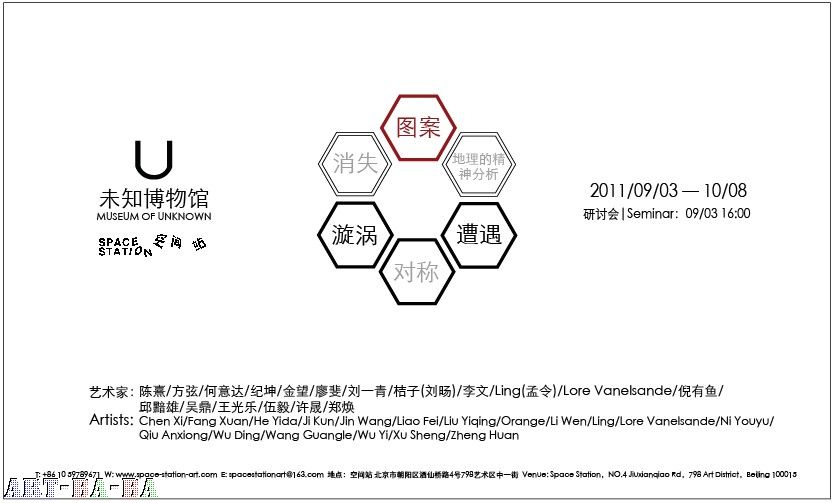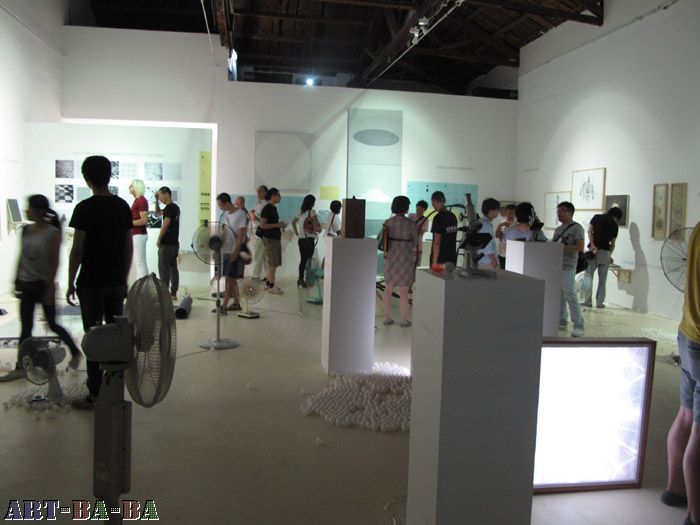第二届新青年影像年度展9月9日-9月18日举办
空间站诚邀您莅临未知博物馆——“图案-漩涡-遭遇”开幕 2011.9.3 16:00
Space Station cordially invites you to the opening of Museum of unknown exhibition "Pattern--Vortex--Encounter" on this Saturday, September 3rd, at 16:00

图案-漩涡-遭遇|Pattern--Vortex--Encounter
参展艺术家 | Artists:陈熹|Chen Xi 方弦|Fang Xuan 何意达|He Yida 纪坤|Ji Kun 金望|Jin Wang 廖斐|Liao Fei 刘一青|Liu Yiqing 桔子(刘旸)|Orange 李文|Li Wen 孟令|Ling Lore Vanelsande 倪有鱼|Ni Youyu 邱黯雄|Qiu Anxiong 吴鼎|Wu Ding 王光乐|Wang Guangle 伍毅|Wu Yi 许晟|Xu Sheng 郑焕|Zheng Huan
开幕 | Opening:16:00 September 3rd .2011(研讨会|Seminar)
展览日期 | Exhibiting Time:2011/09/03 -10/08
地点 | Venue:空间站Space Station 北京市朝阳区酒仙桥路4号798艺术区中一街
T: +86 10 59789671 W: www.space-station-art.com E: spacestationart@163.com
《图案-漩涡-遭遇》
未知博物馆将于2011年9月3日开始组织一个新的项目《图案-漩涡-遭遇》,以艺术与科学的关系为基本范畴,探讨了以下问题:1、今天我们在什么条件下可能去讨论艺术和科学的关系?2、艺术和科学在什么命题上可以对话?3、尝试艺术和科学的合作交流在理论层面的可能性。
展览的基本构架是由六个不同的主题组成,其中三个主题为:图案、漩涡、消失,另外三个主题为:对称、遭遇、地理的精神分析,将分别在不同的展场展示。其中《图案》部分在北京空间站展出,同时科学松鼠会的科学研究者和《新视线》杂志将参与这些话题,进行持续性的对话,并在这些讨论的基础上进行艺术创作的实践。
这些主题的关联性并非仅由阐释来建立,更多是通过作品的生产和对话讨论来建立,也是通过新的展览结构方式来建立起不同主题之间的关联。通常传统展览模式以一个主题作为展览的核心概念,从这个核心的概念出发找到适合的作品和艺术家,艺术家也适应这样一种模式。本次展览由艺术家提出不同的概念来形成不同维度的意义之网,艺术家和参与者在这个网中可以找到自己的位置,与这些概念既可以保持联系,也可以保持距离,不是通常的趋近。同时,一件作品也可以和几个不同的概念产生联系,这种多向度的创作思维也会带来不同的作品形成方式。在展示方式中让作品与作品之间的关联是主动和多维度的,而不是单一主题概念把他们简单地绑在一起。同时,三个不同展厅的内容相互关联,彼此映射。
空间站以“图案”为核心,与图案相关的数学(几何学)、物理学、生物学的文献,在艺术家在与科学家们交流的基础上的创作作品是主要的展示内容。我们还邀请了《新视线》杂志图案专辑的参加,展览将展示专辑中关于图案的地域文化差异,神圣几何等文献。
本次展览项目既是对艺术与科学关系的讨论,同时也是对新的展览结构的尝试。
鸣谢:科学松鼠会、《新视线》杂志
"Pattern--Vortex--Encounter" Press release
In the new project for unknown museum, according to the relations between art and science, the following issues have been discussed: 1. In what conditions, today we may discuss the relationship between art and science? 2. In what issues art and science can be talked with each other? 3. The possibility in theory for cooperation and exchange between art and science?
The basic frame for the exhibition is composed of six different themes, among which three themes are: pattern, whirlpool and disappearance, others are symmetry, encounter and geographical psychoanalysis. They will be shown in three different exhibitions. We also contact to the scientific researchers in scientific squirrel--Juzi and Fangxian, the art directors of the New Outlook magazine--Yang Penghui and Chen Jiaojiao and we will dialogue and discuss with them on these topics. Meantime art practices will be carried based on the discussion.
The relevance of these themes is not only established by interpretation, but also be formed by works and dialogue. In addition to that, the dialogues and relevance among these themes are to be set up by the new frame mode of exhibition. Generally speaking, the traditional exhibition takes a thematic concept as the core idea, then to proceed from this thought and find the suited works and artists to take part in. The artists usually also adapt this kind of mode, and they put forward to different concepts to form a net of different dimensionalities, in which artists and other participants can find their own positions, they can keep distance to these concepts while they are in contact to them, not only approach to them as usual.
In space station, the pattern is the core, and the main contents for exhibition are the documents on mathematics (geometry), physics and biology which related to pattern and the works created based on the exchanges between artists and scientists. We also invite a pattern album in an issue of New Outlook magazine to join us, from which we will display and show those which concerning to pattern and in themes on different regional cultures, sacred geometry, etc.
This project is not only a discussion about the relationship between art and science, but also a try of finding new exhibit forms.
Acknowledgment:Songshuhui.net、New Outlook magazine
--
空间站 | Space Station
T: +86 10 59789671
W: www.space-station-art.com
E: spacestationart@163.com info@space-station-art.com
地点:空间站 北京市朝阳区酒仙桥路4号798艺术区中一街
Venue: Space Station,NO.4 Jiuxianqiao Rd,798 Art District,Beijing 100015
小牛花使用手册:
1、口味三俗,请自带避雷针;
2、我真不是这个意思,您千万别往歪里想。
今天开幕照片拍得不多,都在开讨论会了,改天补上~

“艺术与科学”讨论会我这面能看到的部分全景图:@李淼在微博 @唐克扬工作室 @邱黯雄 @廖斐肥料 @郭芳u @郭宏蔚 @陈亮洁 陈朝 谢墨凛 @王光乐 何意达

回复@李淼在微博: 很有趣的讨论~长见识了~李老师辛苦了~竟然有这么久么~我们还想以后继续请教~~都不好意思了~~ //@李淼在微博:回复@付晓东:讨论了近6个小时艺术,我现在用威士忌消除疲劳。今天真是开眼界了,认识了这么多活的艺术家。
很有趣的讨论~长见识了~李老师辛苦了~竟然有这么久么~我们还想以后继续请教~~都不好意思了~~ //@李淼在微博:回复@付晓东:讨论了近6个小时艺术,我现在用威士忌消除疲劳。今天真是开眼界了,认识了这么多活的艺术家。
@邱黯雄:回复 @付晓东:线下完了线上继续,这样才有持续性
回复@邱黯雄:矮油,你们明明坐在对面,却在这儿讨论呢~~ //@邱黯雄:转发此微博:透视这个概念是在几何学的基础上建立的,中国没有透视的方法,只能说是一种自然的经验视觉观,跟透视没有关系,没必要跟透视拉关系,可以按中国自己的称呼习惯去命名,比如高远平远都很诗意。
@李淼在微博 :邱黯雄说,中国画所谓散点透视是胡扯,其实就是看到哪画到哪。不过他数现代绘画和科学发展有关我不同意,是生活变化造成的,而且文学走在前面。
:邱黯雄说,中国画所谓散点透视是胡扯,其实就是看到哪画到哪。不过他数现代绘画和科学发展有关我不同意,是生活变化造成的,而且文学走在前面。
同日见到了活的物理学家,脑切片专家~//@李淼在微博:见到了活的建筑师,装置艺术家,画家,雕塑家。 //@李淼在微博:我将携本大嘴前往。
@付晓东 :今天下午四点,“图案”展,空间站,798中一街,@未知博物馆 @松鼠科学会 “艺术与科学”讨论会,各种偶像级名嘴大驾光临,欢迎前来围观~
:今天下午四点,“图案”展,空间站,798中一街,@未知博物馆 @松鼠科学会 “艺术与科学”讨论会,各种偶像级名嘴大驾光临,欢迎前来围观~
@邱黯雄:在建筑是这样的,艺术大多不以科学为道路,科学的目的也不是艺术而是认识世界 //@李淼在微博:我喜欢这句话,艺术是目的,科学是道路。
难怪咱事先不知道这定论 ~唐老师说这话题先看贡布里希~//@马清运的微博:我刚编的,但千年人文史沽到我嘴里的。考证工作@唐克扬工作室 最可靠。
~唐老师说这话题先看贡布里希~//@马清运的微博:我刚编的,但千年人文史沽到我嘴里的。考证工作@唐克扬工作室 最可靠。 //@付晓东:这话的出处是?// @马清运的微博 :这事已经清楚、不要讨论了:艺术是目的、科学是道路!/art is purpose, science is process。
//@付晓东:这话的出处是?// @马清运的微博 :这事已经清楚、不要讨论了:艺术是目的、科学是道路!/art is purpose, science is process。
@邱黯雄:问题中包含了答案 //@马清运的微博 :听着很"阴谋"! // @唐克扬工作室 :purposeful processes processed purpose//
付晓东 回复@唐克扬工作室:突然发现,这话题除了唐克扬以外,我们都得冒着外行的风险~ (今天 01:03)
回复@唐克扬工作室:突然发现,这话题除了唐克扬以外,我们都得冒着外行的风险~ (今天 01:03)
唐克扬工作室 回复@马清运的微博:purposeful processes processed purpose
回复@马清运的微博:purposeful processes processed purpose (今天 00:55)
(今天 00:55)
Adrian_WH 艺术是开放的可能性——不同的流派与形式之间并无绝对的高低;而科学是可能性的开放——理论的差异在逻辑模型的不断完善下而趋于统一。

“艺术与科学”讨论会我这面能看到的部分全景图:@李淼在微博 @唐克扬工作室 @邱黯雄 @廖斐肥料 @郭芳u @郭宏蔚 @陈亮洁 陈朝 谢墨凛 @王光乐 何意达

回复@李淼在微博:
 很有趣的讨论~长见识了~李老师辛苦了~竟然有这么久么~我们还想以后继续请教~~都不好意思了~~ //@李淼在微博:回复@付晓东:讨论了近6个小时艺术,我现在用威士忌消除疲劳。今天真是开眼界了,认识了这么多活的艺术家。
很有趣的讨论~长见识了~李老师辛苦了~竟然有这么久么~我们还想以后继续请教~~都不好意思了~~ //@李淼在微博:回复@付晓东:讨论了近6个小时艺术,我现在用威士忌消除疲劳。今天真是开眼界了,认识了这么多活的艺术家。 @邱黯雄:回复 @付晓东:线下完了线上继续,这样才有持续性

回复@邱黯雄:矮油,你们明明坐在对面,却在这儿讨论呢~~ //@邱黯雄:转发此微博:透视这个概念是在几何学的基础上建立的,中国没有透视的方法,只能说是一种自然的经验视觉观,跟透视没有关系,没必要跟透视拉关系,可以按中国自己的称呼习惯去命名,比如高远平远都很诗意。
@李淼在微博
 :邱黯雄说,中国画所谓散点透视是胡扯,其实就是看到哪画到哪。不过他数现代绘画和科学发展有关我不同意,是生活变化造成的,而且文学走在前面。
:邱黯雄说,中国画所谓散点透视是胡扯,其实就是看到哪画到哪。不过他数现代绘画和科学发展有关我不同意,是生活变化造成的,而且文学走在前面。 同日见到了活的物理学家,脑切片专家~//@李淼在微博:见到了活的建筑师,装置艺术家,画家,雕塑家。 //@李淼在微博:我将携本大嘴前往。
@付晓东
 :今天下午四点,“图案”展,空间站,798中一街,@未知博物馆 @松鼠科学会 “艺术与科学”讨论会,各种偶像级名嘴大驾光临,欢迎前来围观~
:今天下午四点,“图案”展,空间站,798中一街,@未知博物馆 @松鼠科学会 “艺术与科学”讨论会,各种偶像级名嘴大驾光临,欢迎前来围观~ @邱黯雄:在建筑是这样的,艺术大多不以科学为道路,科学的目的也不是艺术而是认识世界 //@李淼在微博:我喜欢这句话,艺术是目的,科学是道路。
难怪咱事先不知道这定论
 ~唐老师说这话题先看贡布里希~//@马清运的微博:我刚编的,但千年人文史沽到我嘴里的。考证工作@唐克扬工作室 最可靠。
~唐老师说这话题先看贡布里希~//@马清运的微博:我刚编的,但千年人文史沽到我嘴里的。考证工作@唐克扬工作室 最可靠。 //@付晓东:这话的出处是?// @马清运的微博 :这事已经清楚、不要讨论了:艺术是目的、科学是道路!/art is purpose, science is process。
//@付晓东:这话的出处是?// @马清运的微博 :这事已经清楚、不要讨论了:艺术是目的、科学是道路!/art is purpose, science is process。 @邱黯雄:问题中包含了答案 //@马清运的微博 :听着很"阴谋"! // @唐克扬工作室 :purposeful processes processed purpose//
付晓东
 回复@唐克扬工作室:突然发现,这话题除了唐克扬以外,我们都得冒着外行的风险~ (今天 01:03)
回复@唐克扬工作室:突然发现,这话题除了唐克扬以外,我们都得冒着外行的风险~ (今天 01:03) 唐克扬工作室
 回复@马清运的微博:purposeful processes processed purpose
回复@马清运的微博:purposeful processes processed purpose (今天 00:55)
(今天 00:55) Adrian_WH 艺术是开放的可能性——不同的流派与形式之间并无绝对的高低;而科学是可能性的开放——理论的差异在逻辑模型的不断完善下而趋于统一。
小牛花使用手册:
1、口味三俗,请自带避雷针;
2、我真不是这个意思,您千万别往歪里想。